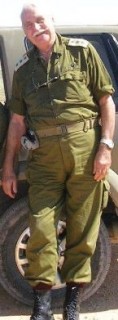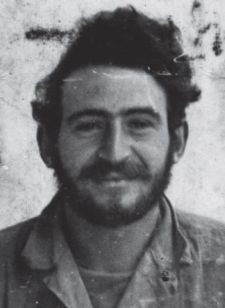David Teperson 1926-2015
Standing at 1.98 meters tall, David Teperson acquired the appropriate nickname - Migdal (tower in Hebrew) while serving with Machal in the 1948 War of Independence. Machal is the Hebrew acronym for Mitnadvei Hutz La'aretz (volunteers from abroad), an aging group which chairman of World Machal, Smoky Simon, refers to as a species on the verge of becoming extinct.
Migdal was on one of the first planes carrying South Africans who volunteered to serve in the War of Independence. Because of the shortage of planes that were prepared to fly into the newly declared State of Israel, he was routed with others to Marseilles where he spent a month training in a D.P. camp, eventually arriving in Israel on one of the last Aliya Bet illegal immigrant ships called the Tetty on the fateful May 15, 1948 a few hours before Ben-Gurion proclaimed the establishment of the state.
Among other commemorative works, Migdal's loyalty to Machal and the IDF later led him to establish a museum in his Kfar Shmaryahu home dedicated to authentically recording the history of the birth and survival of the Jewish state. I was privileged to lead the team that established the Machal website which incorporates much of the invaluable historical records in this museum. See www.machal.org.il
On arriving in Israel, Migdal immediately enlisted in the new rudimentary IDF and was posted to the 34th Battalion of the Alexandroni Brigade, later switching to the 9th Battalion, Negev Brigade, Palmach – "I was looking for more action," he explained. He participated in all operations and battles in the Negev including the operation which claimed Um Rash Rash (now Eilat).
I recall Migdal telling the following anecdote about this episode, illustrative of the manner in which Israel utilized its meager resources. As soon as it got dark, they took all the company's vehicles and some others and traveled without lights on the dirt road 20 to 30 km north of Eilat. They then turned around and drove towards Eilat with lights on, repeating this procedure two or three times each night for a few nights. The trick worked as they later learned on the radio that the Israelis had brought huge numbers of reinforcements into the Um Rash Rash occupied area with the result that the British-led Jordanian army was scared to counterattack.
Migdal married in July 1949 and on his release from the IDF in September 1949 he and Shoshana joined the "garin" of Moshav Habonim. In 1950 they left the moshav so that he could become a construction worker. He graduated to taking on small renovation jobs and eventually he and Shoshana established a very successful construction company.
Migdal started reserve duty in 1950 in the 7th Armored Brigade and then in the 27th Brigade where he served until almost the end. In April 1955 he was commissioned as a lieutenant.
From 1952 he served in Egrof veRomach (Fist & Spear) Reserve Armored Brigade as a supply and control officer and was awarded a special lifetime achievement award by the IDF for this service.
In 1960, he moved to Kfar Shmaryahu and became a security officer and in 1974 he established there the Civil Guard (Mishmar Ezrachi).
Migdal set up the Society for Perpetuation of the Memory of the Fallen of the Egrof VeRomach Brigade and constructed two memorial monuments funded by donations and from his own pocket, one in Givat Ha'koach with the original equipment from Sinai, and a second in the Monument Forest (Yaar Ha'andartaot), in honor of the first Armored Reserve Brigade and the 147 brigade soldiers who fell.
He fought in every one of Israel's wars, two of them with his sons. He continued to do reserve duty way beyond the call-up age - over 60 years, - and was always ready to serve Israel in whatever way he could.
Migdal was promoted to the rank of Lt. Col. in 1987, and he was promoted to full Colonel in 1997.
His achievements are the more remarkable in view of the fact that he suffered from severe dyslexia, a disorder that was not understood in Migdal's schooldays, resulting in his being thrown out of ten schools in South Africa. They then attributed his difficulty in reading to simple laziness.
Migdal has written two books, The Volunteer and In the Eyes of the Beholder and he is featured prominently in the book South Africa's 800.
He is survived by three children, Gadi, Safi, and Idit.
Maurice Ostroff
He easily stood out ... fellow soldiers called him 'Migdal'
Over the past few years big men have become common here in Israel. But the first sight of Davie Teperson in 1948 was unusual to say the least. Almost two meters tall and weighing accordingly, he easily stood out – so much so that his fellow soldiers called him "Migdal" (Hebrew for Tower). We were both in the the 9th Battalion of the Palmach Negev brigade. Davie was in the jeep company and I was in the armored cars. In many ways that time in the army in 1948/49 was formative for him, so much so that he almost single handedly worked to commemorate the entire Machal experience. Machal was the name given to the overseas volunteers who came to Israel's aid in the War of Independence. And what Davie did was set aside his basement and get volunteers to work there gathering and collating material about the Machal contribution to the War of Independence. This material was eventually presented to the Palmach Museum in Ramat Aviv. It will serve to commemorate the Machal volunteers as well as David Teperson's memory.
Mike Rubin, Sderot











Comments